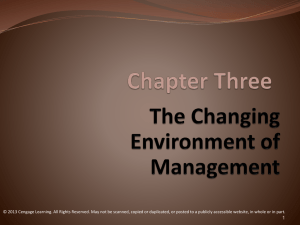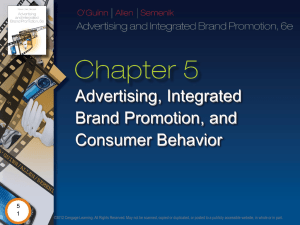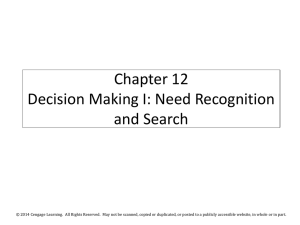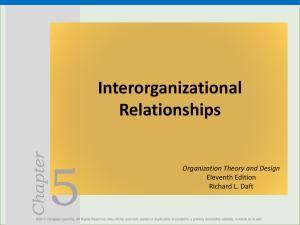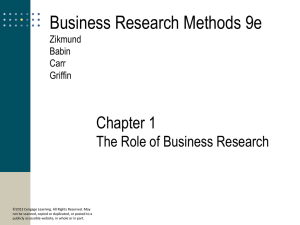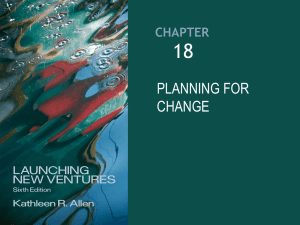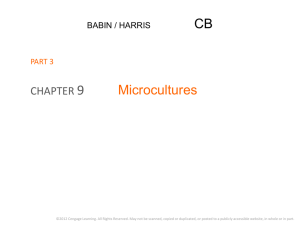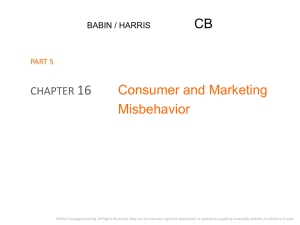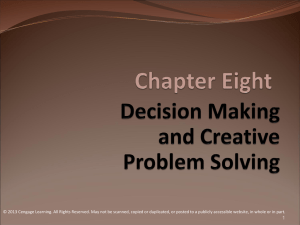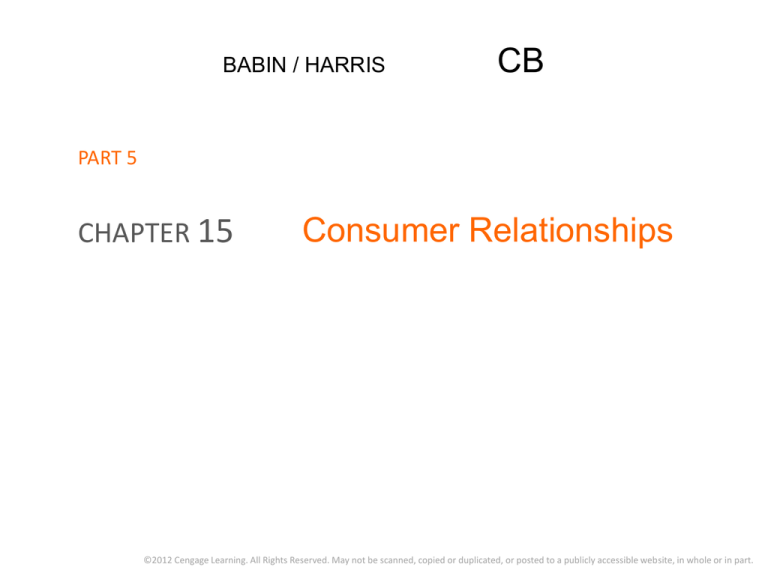
BABIN / HARRIS
CB
PART 5
CHAPTER 15
Consumer Relationships
©2012 Cengage Learning. All Rights Reserved. May not be scanned, copied or duplicated, or posted to a publicly accessible website, in whole or in part.
Learning Outcomes
1. List and define the behavioral outcomes of
consumption.
2. Know why consumers complain and the
ramifications of complaining behavior for a
marketing firm.
3. Use the concept of switching costs to understand
why consumers do or do not repeat purchase
behavior.
4. Describe each component of true consumer
loyalty.
5. Understand the role that value plays in shaping
loyalty and building consumer relationships.
15-2
©2012 Cengage Learning. All Rights Reserved. May not be scanned, copied or duplicated, or posted to a publicly accessible website, in whole or in part.
Outcomes of Consumption
• Expanded disconfirmation framework
• Cognitive processes
•
Procedural justice
• Affective reactions
• Behavioral outcomes
LO1
15-3
©2012 Cengage Learning. All Rights Reserved. May not be scanned, copied or duplicated, or posted to a publicly accessible website, in whole or in part.
Complaining
• Occurs when a consumer actively seeks
out someone to share an opinion with
regarding a negative consumption event.
• Consumers who do complain react with
different emotions (i.e., anger) than do
those who do not complain.
• Complainers are valuable sources of
feedback.
LO2
15-4
©2012 Cengage Learning. All Rights Reserved. May not be scanned, copied or duplicated, or posted to a publicly accessible website, in whole or in part.
Result of Complaining:
Complainers
• More likely to become a satisfied
customer.
• More likely to return.
• Tells others when a company responds
poorly.
• Valuable source of information.
LO2
15-5
©2012 Cengage Learning. All Rights Reserved. May not be scanned, copied or duplicated, or posted to a publicly accessible website, in whole or in part.
Result of Complaining:
Noncomplainers
• Unlikely to return.
• May tell others about experience.
• Can become a satisfied customer if firm
can take preemptive action despite the
lack of a complaint.
LO2
15-6
©2012 Cengage Learning. All Rights Reserved. May not be scanned, copied or duplicated, or posted to a publicly accessible website, in whole or in part.
Handling Service Complaints
Effectively
• Thank the guest for providing the
information.
• Ask questions to clarify the issue.
• Apologize sincerely.
• Show empathy for the customer’s situation.
• Explain the corrective action that will take
place.
• Act quickly.
• Follow up with the customer after the
corrective action.
LO2
15-7
©2012 Cengage Learning. All Rights Reserved. May not be scanned, copied or duplicated, or posted to a publicly accessible website, in whole or in part.
Revenge
• Rancorous revenge—a consumer yells,
insults and makes a public scene in an
effort to harm the business.
• Retaliatory revenge—in extreme cases the
furious consumer can become violent or
try to vandalize the business.
LO2
15-8
©2012 Cengage Learning. All Rights Reserved. May not be scanned, copied or duplicated, or posted to a publicly accessible website, in whole or in part.
Word-of-Mouth (WOM)
• Negative WOM—takes place when
consumers pass on negative information
about a company from one to another.
LO2
15-9
©2012 Cengage Learning. All Rights Reserved. May not be scanned, copied or duplicated, or posted to a publicly accessible website, in whole or in part.
Word-of-Mouth (WOM)
• Positive WOM—occurs when consumers
spread information from one to another
about positive consumption experiences.
LO2
15-10
©2012 Cengage Learning. All Rights Reserved. May not be scanned, copied or duplicated, or posted to a publicly accessible website, in whole or in part.
Handling Negative Publicity
• Do nothing; it will go away.
• Deny responsibility for any negative event.
• Take responsibility for any negative events
and be visible in the public eye.
• Release information allowing the public to
draw its own conclusion.
LO2
15-11
©2012 Cengage Learning. All Rights Reserved. May not be scanned, copied or duplicated, or posted to a publicly accessible website, in whole or in part.
Switching Behavior
• Switching—a consumer chooses a
competing choice, rather than the
previously purchased choice, on the next
purchase occasion.
LO3
15-12
©2012 Cengage Learning. All Rights Reserved. May not be scanned, copied or duplicated, or posted to a publicly accessible website, in whole or in part.
Switching Costs
• Switching costs—the costs associated with
changing from one choice to another.
• Procedural—involves lost time and effort.
• Financial—the total economic resources that
must be spent to obtain value from a new
choice.
• Relational—the emotional and psychological
consequences of changing.
LO3
15-13
©2012 Cengage Learning. All Rights Reserved. May not be scanned, copied or duplicated, or posted to a publicly accessible website, in whole or in part.
Consumer Loyalty
• Customer share—the portion of resources
allocated to one brand from among the set of
competing brands.
•
Also known as share of wallet.
• Customer inertia—a consumer will tend to
continue a pattern of behavior until some
stronger force motivates a change.
• Loyalty card/program—keeps track of the
amount of purchasing a consumer has had
with a given marketer and offers rewards.
LO4
15-14
©2012 Cengage Learning. All Rights Reserved. May not be scanned, copied or duplicated, or posted to a publicly accessible website, in whole or in part.
Customer Commitment
• A strong feeling of attachment, dedication,
and sense of identification with a brand.
• Loyalty is a function of customer share and
customer commitment.
LO4
15-15
©2012 Cengage Learning. All Rights Reserved. May not be scanned, copied or duplicated, or posted to a publicly accessible website, in whole or in part.
Antiloyalty
• Antiloyal consumers—those who will do
everything possible to avoid doing
business with a particular marketer.
LO4
15-16
©2012 Cengage Learning. All Rights Reserved. May not be scanned, copied or duplicated, or posted to a publicly accessible website, in whole or in part.
Relationships and the
Marketing Firm
• The exchange between a business and a
consumer comprise a relationship.
• Customers have a lifetime value to the firm.
• True loyalty involves both a continuing series
of interactions and feelings of attachment
between the customer and the firm.
• Relationship quality—represents the
degree of connectedness between a
consumer and a retailer.
LO5
15-17
©2012 Cengage Learning. All Rights Reserved. May not be scanned, copied or duplicated, or posted to a publicly accessible website, in whole or in part.
Characteristics of Relationship
Quality
•
•
•
•
•
•
Competence
Communication
Trust
Equity
Personalization
Customer oriented
LO5
15-18
©2012 Cengage Learning. All Rights Reserved. May not be scanned, copied or duplicated, or posted to a publicly accessible website, in whole or in part.



